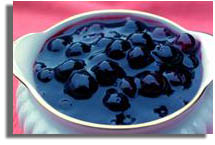|
June 2005
Enjoy Louisiana blueberries. They can help protect against diseases, including
certain cancers and heart disease, according to
LSU AgCenter nutritionist Dr.
Beth Reames.
Blueberries and other brightly colored berries contain vitamins, minerals,
dietary fiber and phytochemicals, which are nonnutritive substances in plants
that promote health and prevent chronic disease.
|

This blueberry sauce contains vitamins, minerals, dietary fiber and
phytochemicals that promote health and prevent chronic disease.
(Recipe included in story). |
|
Antioxidants are phytochemicals that help neutralize harmful by-products of
metabolism called free radicals that contribute to heart disease and other
diseases.
Blueberries are nature's number one source of antioxidants among fresh fruits
and vegetables according to the USDA Human Nutrition Research Center on Aging at
Tufts University in Boston.
Anthocyanins, the pigments giving blueberries their deep blue hue, act as
antioxidants, which may provide many health benefits. In addition, blueberries
are a low-calorie food – only 40 calories in one-half cup. They also are a good
source of vitamin C and fiber.
In addition, blueberries contain compounds that may help to prevent urinary
tract infections (UTIs), according to a report from the Rutgers Blueberry
Cranberry Research Center in Chatsworth, New Jersey.
The compounds, called condensed tannins, can keep the bacteria responsible for
UTIs from attaching to the linings of the urinary and digestive tracts.
The Rabbiteye blueberry is most successfully grown in the South. Some varieties
of Rabbiteye blueberries begin ripening the first week of June and others
through the early part of July. Blueberries from other parts of the country are
plentiful in supermarkets in July and August.
"The soils in many parts of Louisiana tend to be acid, and this is perfect for
growing Rabbiteye blueberries," according to LSU AgCenter horticulturist Dan
Gill. He says blueberry bushes are excellent for small gardens, since they stay
much smaller than most fruit trees. Plants need a spacing of only about 6 feet.
Gill recommends the blueberry cultivars Tifblue, Woodard, Climax, Premier and
Choice. Southern highbush blueberry cultivars, such as Cooper, Gulfcrest, Blue
Ridge and Cape Fear, are other options.
Reames says to look for berries that are dark blue, with a frosty bloom. Store
fresh blueberries in your refrigerator for up to 2 weeks, and wash them just
before you use them, not ahead of time or they'll get mushy.
Loose-pack frozen blueberries are available year-round, and you can use them in
any recipe that calls for fresh blueberries. Since they are pre-washed, they can
be used right from the package.
Blueberries should be plump and firm with a dark blue color and waxy, silvery
"bloom." Sweetness varies by variety. Blueberries do not ripen after harvest, so
as soon as you buy them, you can eat them. One pint of berries will provide four
to five servings of fresh uncooked fruit.
Storage and preparation. Handle fruit gently to avoid bruising. Bruising
shortens the life of fruit and contributes to low quality. Sort carefully and
remove berries that are too soft or decayed. Store berries loosely in a shallow
container to allow air circulation and to prevent the berries on top from
crushing those underneath. Do not wash berries before refrigerating. Store
covered containers of berries in a cool, moist area of the refrigerator, such as
in the hydrator (vegetable keeper), to help extend the usable life of the fruit.
Recommended storage time is three to five days. Before eating berries or using
in your favorite recipe, wash berries gently in cold water, lift out of water
and drain.
Freeze blueberries without washing. When washed before freezing, blueberry skins
become tough. To freeze, remove stems and trash, package tightly in freezer bags
or containers or glass jars, leaving one-half inch headspace. Seal airtight and
freeze. Remove from freezer, rinse in cold water and use immediately.
Use frozen berries directly from the freezer. There's no need to thaw them if
you use them in baked products, except for pancakes. Pancakes may not cook
thoroughly in the center if the berries are frozen. Microwave the amount you
need for a few seconds to thaw.
Reames offers additional tips for serving blueberries.
Breakfast. Toss blueberries into your favorite hot or cold cereal, add
blueberries when making pancakes, muffins, breakfast breads and waffles, add
blueberries to non-fat yogurt, or pile blueberries into a cantaloupe half.
Snacking. Eat blueberries out of hand, make a blueberry blender drink with
non-fat yogurt, mix blueberries with non-fat cottage cheese, drop frozen
blueberries in sparkling water for a refreshing summer drink.
Meals. Sprinkle blueberries into fruit or green salads, make a tangy blueberry
sauce to serve with poultry, fish and meat.
Desserts. Serve a dish of blueberries for dessert or use blueberries as a
topping for low-fat ice cream, frozen yogurt, sorbet, fruit or angel food cake.
Bake a blueberry cobbler or pie. Make blueberry sauce and use as a topping on
pancakes, waffles, ice cream, pudding or angel food cake.
Blueberry sauce. Serves 8 (1/4-cup servings). Ingredients: 2 cups fresh or
frozen wild blueberries, 1 tablespoon cornstarch, 1/2 cup water, l teaspoon
lemon juice, 1/4 cup sugar, 1/8 teaspoon cinnamon.
Directions: Add water to berries; heat until warm. Combine cornstarch, sugar and
cinnamon; stir into berry mixture. Stir and cook until mixture is thickened and
clear. Add lemon juice and mix.
|